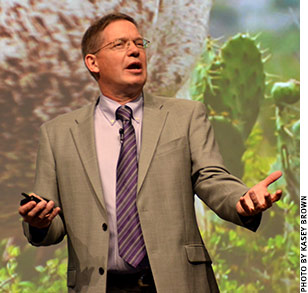Outlook for Cattle and Beef Supplies
SAN ANTONIO, Texas (Feb. 5, 2015) — Improved moisture in a significant portion of cow country, lower feed costs and record-high calf prices favor expansion of the U.S. cow herd. Cattle-industry and market analyst Kevin Good painted a relatively rosy picture for cow-calf producers during the CattleFax Outlook Seminar Feb. 5 at the 2015 Cattle Industry Convention & NCBA Trade Show in San Antonio, Texas. However, Good said, the picture isn’t so pretty for cattle feeders.

Kevin Good expects the 2015 calf crop to increase for the first time since 2006.
Citing two signs of expansion, Good said beef cow slaughter is expected to decline by up to 300,000 head in 2015, while heifer retention appears to be increasing. Evidence of the latter shows in the reduction of heifers in the fed-cattle mix. With Mother Nature’s cooperation, herd expansion is expected to continue at least through 2016.
Good expects the 2015 calf crop to increase for the first time since 2006. However, the 2014 crop was some 500,000 head smaller than the year previous. Tight feeder-cattle and calf supplies will force cattle feeders to bid aggressively until fall. Cattle feeders continue to push fed weights to upper limits. Average carcass weights are expected to be 8 pounds (lb.) heavier than last year due to lower costs of gain. Total beef production for 2015 is projected to be 1% smaller — down from last year by about 250 million lb. — as a result of lower fed and non-fed slaughter.
According to Good, pork and broiler producers are ramping up production. Hog slaughter for 2015 is expected to increase by 3.3%, and poultry production should increase by greater than 4%.
“Roll it all together and our tightest protein supplies are behind us,” stated Good.
The forecast calls for corn prices to range from $3.50 to $4.25 per bushel (bu.) into the spring, with the low end of the range slipping to $3.10 per bu. during the second half of 2015. Relatively inexpensive feed costs won’t keep cattle feeders from experiencing negative margins until corn prices slide to the lower levels. Fed-cattle prices are likely to range from $140 to $175 and average around $157 per hundredweight (cwt.).
“The feeding industry has the incentive to make cattle big,” added Good. “If fed prices drop below breakeven, this could be a mess.”
Believing a trend change is in place, Good said 750-weight feeder steer prices will range from $195 to $240 per cwt., averaging around $220 per cwt. in 2015. Calf prices are expected to average $260, ranging from $235 to $290 per cwt.
Strong demand for bred females should put bred heifer prices in the neighborhood of $2,500 per head. The trading range for cull cows is expected to be fairly narrow, ranging from a low of $90 to a high near $125 per cwt.
“The feedlot outlook is negative for the year, so risk management will be important,” concluded Good. “Stocker-background operations will have narrow margins, while the cow-calf sector remains robust and supportive to expansion.”
Editor’s Note: The articles used within this site represent a mixture of copyrights. This article was written by staff or under contract for the Angus Journal. If you would like to reprint or repost an article, you must first request permission of the Angus Journal by contacting the editor at 816-383-5200; 3201 Frederick Ave., Saint Joseph, MO 64506. The Angus Journal claims copyright to this website as presented. We welcome educational venues and cattlemen to link to this site as a service to their audience.

